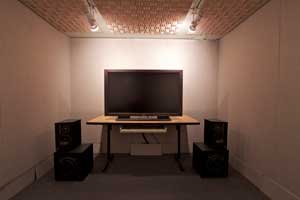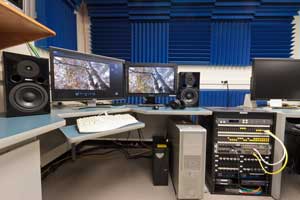Institute for Telecommunication Sciences / Research / Quality of Experience / Video Quality Research / White Papers (obsolete) / Laboratory
Audio-Visual Laboratories
Subjective Testing Facilities
 |
| Sound Isolation Booth |
Subjective testing is simply asking a person's opinion. This is the most accurate way to measure the perceived quality of a phone conversation or video stream.
Designing a subjective test can be tricky. The way one asks a person's opinion can influence the answer the person will give. Experts create ITU Recommendations that list "best practices." These attempt to minimize unwanted influence on a person's answer. When subjective tests are designed with care, they can be highly repeatable, that is, results are the same regardless of where or when the test takes place.
A controlled test environment can enhance repeatability. A person's attention is focused on the task at hand since the lighting is controlled, there is little or no background noise, and there are no visual distractions. A controlled room also frees the experimenter from considering environmental variables when analyzing the test results. ITS has three such rooms: two are identically constructed sound isolation chambers; one is a secluded, quiet room.
The two identical rooms can be connected to allow two persons to converse using audio, video, or both. This type of testing can reveal problems that are not apparent when people only listen to audio recordings or view video. An important example is audio delay-if it is too long, conversation becomes difficult.
The third subjective test room is a larger, quiet room with a window. This room provides flexibility, but a little less control. Currently, the third test room looks like a living room. This sets a different context for questions about audio and video quality.
Unique Capabilities
Because subjective testing is so time intensive and requires such expensive resources, only a few organizations in the United States perform them. Significant expenses are:
-
Subjective test facility construction and operation
Video Workstation - Accurate audio and video play back
- Experiment design and implementation
- Production of audio and video recordings that match the test purpose
- Simulation of audio and video
systems
ITS has proven expertise in designing and conducting subjective experiments. Over the past two decades, ITS has published the results from dozens of subjective experiments.
One surprisingly difficult problem is audio and video playback. Many audio and video players cannot guarantee that every person will see and hear exactly the same audio or video. ITS uses studio-quality hardware and special purpose software tools to ensure reliable playback. These playback systems often push cutting-edge computer hardware to its limit.
Simulating modern audio and video distribution is expensive because there are many methods in use in the telecommunication industry. The ITS audiovisual lab has a variety of hardware and software tools that encode, transmit, or play audio and video, and simulate how people use audio and video today. These tools span a wide range of audio and video services:
- Broadcast quality audio and video
- Satellite TV and Cable TV
- Video on Demand
- Streaming internet video
- Video teleconferencing
- Cell phone audio and video
- VoIP
Audio and Video Capabilities
The ITS audiovisual lab includes support for the following technologies:
- Studio quality analog and digital video recorders with 2 to 8 audio channels
- Subjective test chambers compliant with ITU-T Rec. P.800, ITU-R Rec. BT.500 and ITU-T Rec. P.900
- Studio quality analog and digital video recorders with 2 to 8 audio channels
-
Standard definition (SD) television
Simulated Living Room - High definition television (HDTV)
- Three dimensional television (3DTV)
- Monophonic, stereophonic, and 5.1-channel audio streams
- Digital audio recorders
- Analog audio mixing, filtering, and equalization
- Studio quality video monitors, monitor loudspeakers and headphones
- Telephone handsets
- Various hardware and software encoders and decoders
- Internet protocol network error simulator compliant with ITU-T Rec. G.1050




